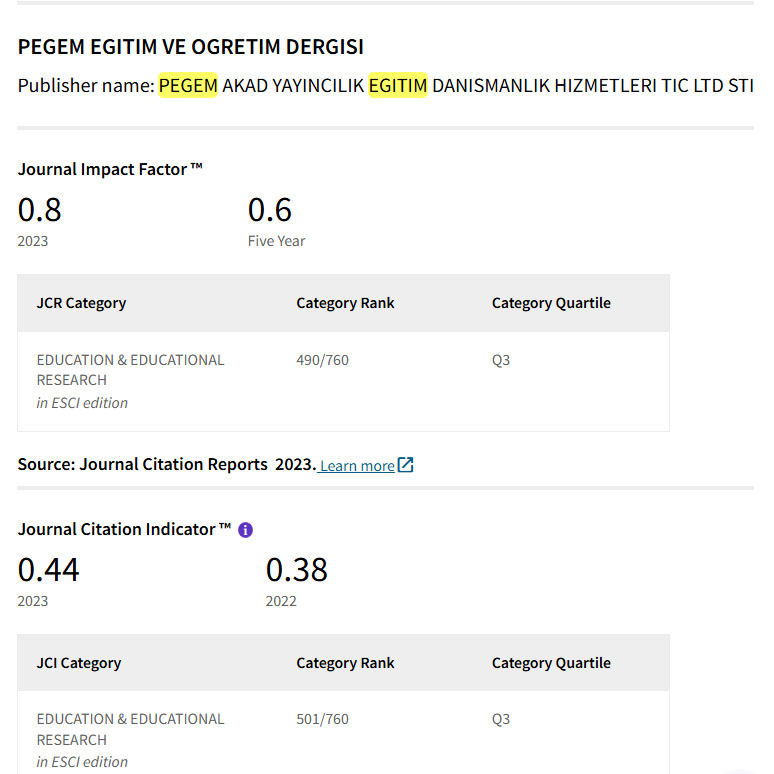Determining the misunderstandings of Physics And Science teacher candidates about the events related to the buoyancy force
DOI:
https://doi.org/10.47750/pegegog.12.01.23Keywords:
Physics education, science education, students' misunderstandings in physics, computer simulations, buoyancy force, MisconceptionsAbstract
The purpose of the study is to explore how pre-service teachers perceive buoyancy force affecting an object in a liquid and identify their misunderstandings and misconceptions. Pre-service teachers were interviewed to reveal their understandings of an object' floating, suspending and sinking in a liquid. In addition, they were asked about how an object-given its features- moved when it is provided with an external force and when it is released. The so-called circumstances were questioned in a different planet context. For this aim, focused group interview method was used. Work-group of the research was formed with senior year physics teaching department students and senior year sciencs teaching department students studying at two different university in Turkey. Seven focused groups were formed and video recorded during the interval. Each focused group comprised of six pre-service teachers. It was found out pre-service teachers have common misunderstanding and misconceptions. In this study, unlike similar studies, it was determined that pre-service teachers had misunderstandings about the movement that a floating object would take after it was sunk and released, and they also had some misunderstandings when the buoyancy force events were repeated on a planet with a different gravitational acceleration .
Downloads
References
Bozkurt, E., & Ilik, A. (2010). The effect of computer simulations over students’ beliefs on physics and physics success. Procedia-Social and Behavioral Sciences, 2(2), 4587-4591.
Çepni, S. & Şahin, C. (2012). effect of different teaching methods and techniques embedded in the 5e instructional model on students' learning about buoyancy force. Eurasian Journal of Physics & Chemistry Education, 4(2), 97–127.
Eryilmaz, A. (2002). Effects of conceptual assignments and conceptual change discussions on students' misconceptions and achievement regarding force and motion. Journal of research in science teaching, 39(10), 1001-1015.
Hammer, D. (1994). Epistemological beliefs in introductory physics. Cognition and instruction, 12(2), 151-183.
Hammer, D. (1995). Epistemological considerations in teaching introductory physics. Science Education, 79, 393–413.
Hewson, M. G., & Hewson, P. W. (1983). Effect of instruction using students' prior knowledge and conceptual change strategies on science learning. Journal of Research in Science Teaching, 20(8), 731-743.
Hung, W., Jonassen, D.H. (2006). Conceptual understanding of causal reasoning in physics. International Journal of Science Education, 28(13), 1601 – 1621.
Kawasaki, K., Herrenkohl, L. R. & Yeary, S. A. (2004). Theory building and modeling in a sinking and floating unit: a case study of third and fourth-grade students' developing epistemologies of science, International Journal of Science Education, 26(11), 1299–1324.
Linder, C.J. 1992. Is teacher-reflected epistemology a source of conceptual difficulty in physics? International Journal of Science Education 14: 111–21.
Lising, L., and A. Elby 2005. The impact of epistemology on learning: A case study from introductory physics. American Journal of Physics 73, no. 4: 372–82.
Moore, T. & Harrison, A. (2004). Everyday Science in middle school: Floating and sinking concepts. AARE Annual Conference, Melbourne.
Özsevgeç, T. & Çepni, S. (2006). Students’ understanding levels floating and sinking concepts in different grade. Journal of National Education (Milli Eğitim Dergisi), 172, 297-311.
Şahin, Ç. & Çepni, S. (2011). Developing of the concept cartoon, animation and diagnostic branched tree supported conceptual change text: “Gas pressure”. Eurasian J. Phys. Chem. Educ.,Special Issue, 25-33.
She, H.C. (2002). Concepts of a higher hierarchical level require more dual situated learning events for conceptual change: A study of air pressure and buoyancy. International Journal of Science Education, 24(9), 981–996, DOI: 10.1080/09500690110098895.
Shen, J., Liu, O. L., & Chang, H. Y. (2015). Assessing students’ deep conceptual understanding in physical sciences: an example on sinking and floating. International Journal of Science and Mathematics Education, Advance online publish, doi:10.1007/s10763-015-9680-z.
Simanjuntak, M. P., Hutahaean, J., Marpaung, N., & Ramadhani, D. (2021). Effectiveness of problem-based learning combined with computer simulation on students' problem-solving and creative thinking skills. International Journal of Instruction, 14(3), 519-534.
Tural, G., Akdeniz, A.R. & Alev, N. (2010). Effect of 5E teaching model on student teachers’ understanding of weightlessness. Journal of Science Education and Technology, 19(5), 470–488.
Yildirim, F. S. (2020). The effect of the augmented reality applications in science class on students' cognitive and affective learning. Journal of Education in Science Environment and Health, 6(4), 259-267.
Yildirim, F. S. (2021). Effectiveness of augmented reality implementation methods in teaching Science to middle school students, International Journal of Curriculum and Instruction, vol. 13, no. 2, pp. 1024-1038.
Yin, Y., Tomita, M.K. & Shavelson, R.J. (2008). Diagnosing and dealing with student misconceptions: Floating and sinking. Science Scope,31(8), 34-39.
Zeineddin, A., & Abd-El-Khalick, F. (2010). Scientific reasoning and epistemological commitments: Coordination of theory and evidence among college science students. Journal of Research in Science Teaching, 47(9), 1064–1093.
Downloads
Published
How to Cite
Issue
Section
License
Copyright (c) 2021 Pegem Journal of Education and Instruction

This work is licensed under a Creative Commons Attribution-NonCommercial 4.0 International License.
Attribution — You must give appropriate credit, provide a link to the license, and indicate if changes were made. You may do so in any reasonable manner, but not in any way that suggests the licensor endorses you or your use.
NonCommercial — You may not use the material for commercial purposes.
No additional restrictions — You may not apply legal terms or technological measures that legally restrict others from doing anything the license permits.




